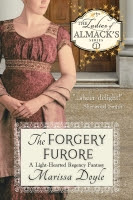 A few weeks back in the Fashion Forecast for 1835 we saw a lovely Evening Dress in a vibrant green fabric. Charming, yes...and, as it happens, extremely dangerous.
A few weeks back in the Fashion Forecast for 1835 we saw a lovely Evening Dress in a vibrant green fabric. Charming, yes...and, as it happens, extremely dangerous.The dye that created that lovely fabric--and similar green tints in things from shoe leather to wallpaper—was created from arsenic. Before the early nineteenth century, there was no color-fast green dye; in order to get anything vaguely green, fabric had to be dyed yellow, then overdyed with blue...which though popular (readers of Regency fiction will recognize this if I call it by its name of the time—Pomona green), generally didn’t hold up very well.
 Then a German chemist created the first colorfast green dye using copper and arsenic; known as Scheele’s Green, it was a hit, though it did tend to blacken in the presence of sulphur compounds. A later refinement in 1814 led to the creation of Paris Green, also known as Emerald Green—and green became an immensely fashionable color, as we’ve seen on some of the prints I’ve posted. Everyone wanted green dresses, green shoes, artificial greenery to wear in headpieces and millinery. They also wanted Emerald Green décor, so upholstery and drapery fabrics, green carpets, and most of all wallpaper became The Thing right through the 1870s. Even Napoleon in exile on St. Helena had green wallpaper in his house...which may have contributed to his death.
Then a German chemist created the first colorfast green dye using copper and arsenic; known as Scheele’s Green, it was a hit, though it did tend to blacken in the presence of sulphur compounds. A later refinement in 1814 led to the creation of Paris Green, also known as Emerald Green—and green became an immensely fashionable color, as we’ve seen on some of the prints I’ve posted. Everyone wanted green dresses, green shoes, artificial greenery to wear in headpieces and millinery. They also wanted Emerald Green décor, so upholstery and drapery fabrics, green carpets, and most of all wallpaper became The Thing right through the 1870s. Even Napoleon in exile on St. Helena had green wallpaper in his house...which may have contributed to his death. Everyone loved the new, rich green dye, but didn’t entirely understand its toxicity. When the recipe was first published in the early 1820s, a few far-seeing physicians cautioned against its use. Dye manufacturers tried tinkering with the ingredients to mitigate and conceal the deadly nature of Emerald Green...and eventually resorted to the simple expedient of changing its name.
Everyone loved the new, rich green dye, but didn’t entirely understand its toxicity. When the recipe was first published in the early 1820s, a few far-seeing physicians cautioned against its use. Dye manufacturers tried tinkering with the ingredients to mitigate and conceal the deadly nature of Emerald Green...and eventually resorted to the simple expedient of changing its name.By the 1870s, synthetic green dyes began to be developed and the demand for Emerald Green decreased...but not before thousands died from wearing green clothes, living in green rooms, eating confections dyed with Emerald Green...as well as the workers who made those clothes or otherwise came in contact with it. For anyone near Toronto, there’s what looks like a pretty cool exhibit at the Bata Shoe Museum called Fashion Victims: The Pleasures and Perils of Dress in the 19th Century that details the dangers of Emerald Green and more. It’s open through next June—if anyone gets to it, let me know!





2 comments:
My word! I had no idea. And it's such a pretty color!
I know! I would have loved a dress in that green...!
Post a Comment